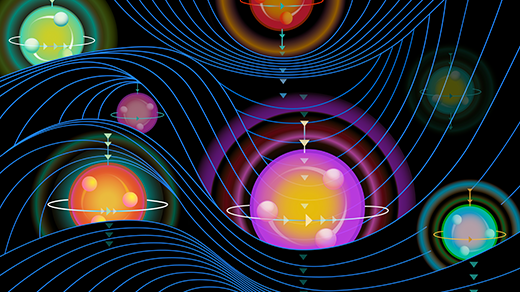A Seeker of Dark Matter’s Hidden Light

Make it. Shake it. Break it. That’s the three-part refrain of dark-matter detectives, including Tracy Slatyer, a theoretical physicist at the Massachusetts Institute of Technology.
We don’t know what kinds of particles are responsible for dark matter, the missing mass that outweighs the universe’s normal matter by a factor of five. We don’t know how big they are or how they behave. But there are three possible paths to finding out: We can hope to make them in accelerators like the Large Hadron Collider (LHC). We can try to sense them as they collide with and shake Standard Model particles in sensitive direct-detection experiments. Or — the method Slatyer focuses on — we could check them as they wreck themselves, watching through telescopes as they crash together or decay out in space, producing a faint, luminous signal.
So far, researchers have drawn a blank. The LHC has failed to make new particles beyond the Higgs boson. Direct-detection experiments also haven’t picked up a conclusive signal. And astronomical searches for dark matter haven’t returned any hard evidence of its identity. Yet many scientists, including Slatyer, argue that the sheer number of telescopes observing the cosmos makes it more feasible for astrophysicists to do broad searches for many different types of dark-matter particles. “Because we do astrophysics, we already have these telescopes that cover a huge range of energies,” Slatyer said.
Slatyer’s career thus far demonstrates how the new era of open-source astrophysics data allows early-career researchers who wouldn’t ordinarily be able to secure observing time on a big telescope to make important discoveries. In 2009, NASA’s gamma-ray-sensitive Fermi telescope released its data to the public. Shortly thereafter, observers including Slatyer pointed out two locations where extra gamma rays were being produced: one at the very core of the Milky Way, and another just around it.
This is exactly the kind of signal that dark matter is thought to be able to produce. Colliding dark-matter particles could give off electrons and positrons; these could accelerate nearby photons to gamma-ray energies. The gamma rays would appear to emanate from a thick dark-matter cloud that astronomers could infer separately from gravitational evidence. The connection would be clear.
In 2010, Slatyer, then a graduate student at Harvard University, along with her fellow graduate student Meng Su and their adviser, Douglas Finkbeiner, showed that the gamma-ray haze around the center of the Milky Way was not a diffuse cloud but two massive bubbles of plasma linked to the black hole at the center of the galaxy, structures now named the “Fermi bubbles.” Then, in 2015, Slatyer was part of a team that argued that the gamma-ray excess in the galactic center itself may have been caused not by dark matter, but by a previously unknown population of faint, mysterious astrophysical objects — probably pulsars.
Slatyer is now working to determine exactly what is creating all those extra gamma rays in the galactic center. She’s also considering how dark-matter annihilation could have changed the history of the cosmos. Quanta caught up with her recently to chat about these projects. An edited and condensed version of the conversation follows.
QUANTA MAGAZINE: When the Fermi data first appeared, you and others suspected that the strong gamma-ray signal at the center of the galaxy might be coming from dark-matter annihilation. But you don’t think so anymore, do you?
TRACY SLATYER: My personal guess at the moment is that this is some new population of gamma-ray point sources, probably some new population of pulsars. But it’s a really weird population! I mean, it doesn’t look like the disk of the galaxy at all. It looks like a new population that’s systematically fainter than the pulsars that Fermi has already seen. We don’t really have a good explanation yet for where these pulsars would have come from, and we haven’t yet confirmed that they are pulsars. It’s quite a puzzle.
So even if it’s not dark matter, it’s unclear what astronomical objects could so comprehensively mimic what dark matter should look like?
I think it would be very good for the field if we could understand the astrophysics that can give rise to signals like this. Because this looks a lot like the dark-matter signal. If it’s not dark matter, it’s a very effective fake. It has pretty much the right spectrum. It has a spatial distribution that is very much what we would expect from dark-matter annihilation. If we’re going to do searches for dark matter, we need to understand signals like this.
Of course I’d like to discover dark matter, but part of the reason I did science in the first place is that it’s so cool to find something that nobody has ever seen before. With these signals, I want to know what they are; I want to know what the answer is. If the answer is dark matter, that would be great, but I just want to know what the answer is.
How did you get into this niche between particle physics and astronomy?
I went to Harvard for grad school thinking: OK, I’m going to work on extra-dimensional models of the universe with Lisa Randall and Nima Arkani-Hamed. At the end of my first year, Nima announced that he was moving to [the Institute for Advanced Study at] Princeton, and Lisa announced that she was going on sabbatical. And I went: Hmm, a plan B is required. Very much to my good fortune, I was introduced to a new young professor in the astrophysics department named Doug Finkbeiner. And Doug at that time was looking for a student with some particle physics training. I had been talking to a lot of particle physicists, and at that stage the whole field was really just waiting with bated breath for the LHC to switch on and finally start giving us data. But when I talked to Doug, I found out that in astrophysics there were all these data around, and the number of people seriously digging into that information was much smaller than the number of people planning to work on LHC data, especially if you focused in on people looking for the signals of new fundamental physics.
I was like: Well, there are all these data, there are all these unanswered questions, there all these signals hiding in these data that might be telling us something very interesting, and there’s a shortage of people to work on them. I can do that.
Dark matter is, by definition, invisible. It’s also undiscovered. How do you know what to look out for?
Suppose you say: All right, I’m going to hypothesize that my dark-matter particles collide, and that when they collide, they annihilate and produce Standard Model particles. Now, this has presumably been happening for the whole lifetime of the universe. If the annihilation rate is too fast, you wouldn’t have any dark matter left today. If it’s too slow, you would have too much dark matter left today. Just from measuring the amount of dark matter in the universe — which has been done — we could predict how rapidly dark-matter particles should be colliding and converting into Standard Model particles. Then that gives us an estimate for how large a signal we should see from various objects.
According to this estimate, should we be able to observe dark-matter annihilations today?
Katherine Taylor for Quanta Magazine
Video: Tracy Slatyer explains why she’s not disappointed when a mysterious cosmic signal turns out to be something other than dark matter.
We are genuinely at a pretty interesting time. If the dark matter is less than about 100 gigaelectron volts — about 100 times the mass of a proton — then we should already be seeing annihilation signals from dwarf galaxies. Just with our current telescopes. We should only have started to see it in the past couple of years. So we’re right at a special moment when our telescopes are probing this very interesting region.
You’re also looking back in time, for evidence of dark-matter annihilation in the early universe. How might that have worked?
So, there are potentially quite a few interesting effects. There was a period in our universe’s history before the stars turned on, or the galaxies turned on, when the universe was a pretty low-energy place, as Donald Trump might say. It was basically just a mass of neutral hydrogen and neutral helium and dark matter, with clumps of dark matter here and there.
If dark-matter annihilation in the early universe acted as this continuous, ubiquitous pump of high-energy particles into the visible universe, it could have had pretty striking effects on the evolution of that dark universe. That’s not something that can be easily mimicked by astrophysical processes.
We have observational handles on that period. We have the photons of the cosmic microwave background, which are emitted at the start of this period, and they travel to us through that period — through this dark, neutral universe. Any changes to it leave imprints on the cosmic microwave background that we can measure very sensitively.
Once you get into the period where stars are starting to turn on, where galaxies are starting to form, the dark matter is also clumping up, and so dark-matter collisions can become much more frequent. Dark matter again at this period could provide this steady stream of high-energy particles. Those particles can ionize the hydrogen; they can heat it up.
In a paper from this April, though, it seems like you argue that dark matter couldn’t have changed the early universe much. Does that mean these effects would be subtle, at best?
We were looking at one very specific question, which was: Could dark matter have played a significant role in reionization, the period in which the universe went from being almost completely neutral to almost completely ionized quite abruptly? And what we found is that it’s hard for dark-matter annihilation or decay to contribute a lot to that particular process.
So that paper was just a stab at that one first question, but the broader program is to understand more generally what are the potential observable impacts of dark-matter annihilation or decay from the cosmic dark ages through the period close to reionization.
Looking forward, are there any other ideas you’re working on for new dark-matter signatures?
There’s a cute problem I’ve been thinking about for a while. I suspect that for this particular model the interesting signatures are not observable in the immediate future, so this is kind of a further-future story.
The idea of the dark sector is that maybe the dark matter isn’t the only new particle. Maybe the dark matter will interact with itself through a force that it feels and that ordinary matter doesn’t, in the same way that ordinary matter feels electromagnetism and dark matter doesn’t.
If I have two particles of opposite charge, the fact that there is electromagnetic attraction between them means they are much more likely to collide with each other. So, in the same way, if the dark matter has its own force, that makes it much more likely to interact with itself. If you think about the other things that pairs of charged particles could do under the electromagnetic force, one thing that happens is that they form atoms. And in these dark sectors you could have similar effects. Dark matter could form atom-like bound states.
Eventually this bound state will probably annihilate, so it would destroy itself in the same way that dark-matter annihilation usually works, providing a cascade of Standard Model particles. But the formation of the bound state, and transitions between different bound states, could also produce lower-energy photons. In some distant, far-future scenario, if you did see the dark-matter annihilation signal, then searching for this little forest of spectral lines from the bound-state transitions could potentially give you a lot of information on the particle physics of the dark matter — even if, for example, it was too heavy to ever make in the LHC.
Just this question, of how do you properly compute the formation of bound states and figure out their impact on observations, is something I’ve been thinking about for a long while.
So we might learn about dark matter from its spectral lines?
You’d see the high-energy event, which is like a positron-electron annihilation, where all the energy of the dark matter gets converted into Standard Model products, but you would also get the little forest of transition lines at much lower masses, probably, and they would be telling you about the potential the dark matter experiences, how it interacts with force carriers.
You could do dark-matter spectroscopy. But we’d have to actually find the dark-matter signal first before you thought about doing dark-matter spectroscopy!
This article was reprinted on Wired.com.



